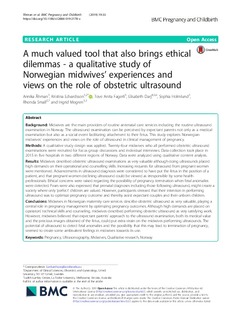| dc.contributor.author | Åhman, Annika | |
| dc.contributor.author | Edvardsson, Kristina | |
| dc.contributor.author | Fagerli, Anita | |
| dc.contributor.author | Darj, Elisabeth | |
| dc.contributor.author | Holmlund, Sofia | |
| dc.contributor.author | Small, Rhonda | |
| dc.contributor.author | Mogren, Ingrid | |
| dc.date.accessioned | 2019-09-25T11:54:23Z | |
| dc.date.available | 2019-09-25T11:54:23Z | |
| dc.date.created | 2019-02-27T14:50:43Z | |
| dc.date.issued | 2019 | |
| dc.identifier.citation | BMC Pregnancy and Childbirth. 2019, 19:33 1-11. | nb_NO |
| dc.identifier.issn | 1471-2393 | |
| dc.identifier.uri | http://hdl.handle.net/11250/2618731 | |
| dc.description.abstract | Background: Midwives are the main providers of routine antenatal care services including the routine ultrasound examination in Norway. The ultrasound examination can be perceived by expectant parents not only as a medical examination but also as a social event facilitating attachment to their fetus. This study explores Norwegian midwives’ experiences and views on the role of ultrasound in clinical management of pregnancy.
Methods: A qualitative study design was applied. Twenty-four midwives who all performed obstetric ultrasound examinations were recruited for focus group discussions and individual interviews. Data collection took place in 2015 in five hospitals in two different regions of Norway. Data were analyzed using qualitative content analysis.
Results: Midwives described obstetric ultrasound examinations as very valuable although doing ultrasounds placed high demands on their operational and counselling skills. Increasing requests for ultrasound from pregnant women were mentioned. Advancements in ultrasound diagnosis were considered to have put the fetus in the position of a patient, and that pregnant women declining ultrasound could be viewed as irresponsible by some health professionals. Ethical concerns were raised regarding the possibility of pregnancy termination when fetal anomalies were detected. Fears were also expressed that prenatal diagnoses including those following ultrasound, might create a society where only ‘perfect’ children are valued. However, participants stressed that their intention in performing ultrasound was to optimize pregnancy outcome and thereby assist expectant couples and their unborn children.
Conclusions: Midwives in Norwegian maternity care services describe obstetric ultrasound as very valuable, playing a central role in pregnancy management by optimizing pregnancy outcomes. Although high demands are placed on operators’ technical skills and counseling, midwives described performing obstetric ultrasound as very satisfying work. However, midwives believed that expectant parents’ approach to the ultrasound examination, both its medical value and the precious images obtained of the fetus, could put extra strain on the midwives performing ultrasounds. The potential of ultrasound to detect fetal anomalies and the possibility that this may lead to termination of pregnancy, seemed to create some ambivalent feelings in midwives towards its use. | nb_NO |
| dc.language.iso | eng | nb_NO |
| dc.publisher | BMC | nb_NO |
| dc.rights | Navngivelse 4.0 Internasjonal | * |
| dc.rights.uri | http://creativecommons.org/licenses/by/4.0/deed.no | * |
| dc.title | A much valued tool that also brings ethical dilemmas-a qualitative study of Norwegian midwives' experiences and views on the role of obstetric ultrasound | nb_NO |
| dc.type | Journal article | nb_NO |
| dc.type | Peer reviewed | nb_NO |
| dc.description.version | publishedVersion | nb_NO |
| dc.source.pagenumber | 1-11 | nb_NO |
| dc.source.volume | 19:33 | nb_NO |
| dc.source.journal | BMC Pregnancy and Childbirth | nb_NO |
| dc.identifier.doi | 10.1186/s12884-019-2178-x | |
| dc.identifier.cristin | 1681083 | |
| dc.description.localcode | © The Author(s). 2019 Open Access This article is distributed under the terms of the Creative Commons Attribution 4.0. Open Access This article is distributed under the terms of the Creative Commons Attribution 4.0 International License (http://creativecommons.org/licenses/by/4.0/), which permits unrestricted use, distribution, and reproduction in any medium, provided you give appropriate credit to the original author(s) and the source, provide a link to the Creative Commons license, and indicate if changes were made. The Creative Commons Public Domain Dedication waiver (http://creativecommons.org/publicdomain/zero/1.0/) applies to the data made available in this article, unless otherwise stated. | nb_NO |
| cristin.unitcode | 1920,13,0,0 | |
| cristin.unitcode | 194,65,20,0 | |
| cristin.unitname | Kvinneklinikken | |
| cristin.unitname | Institutt for samfunnsmedisin og sykepleie | |
| cristin.ispublished | true | |
| cristin.fulltext | original | |
| cristin.qualitycode | 1 | |

